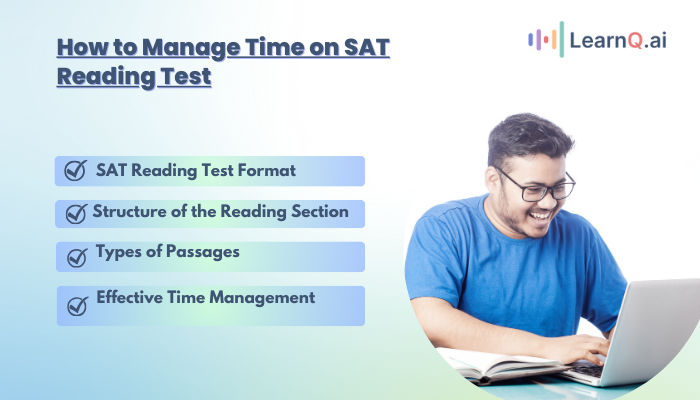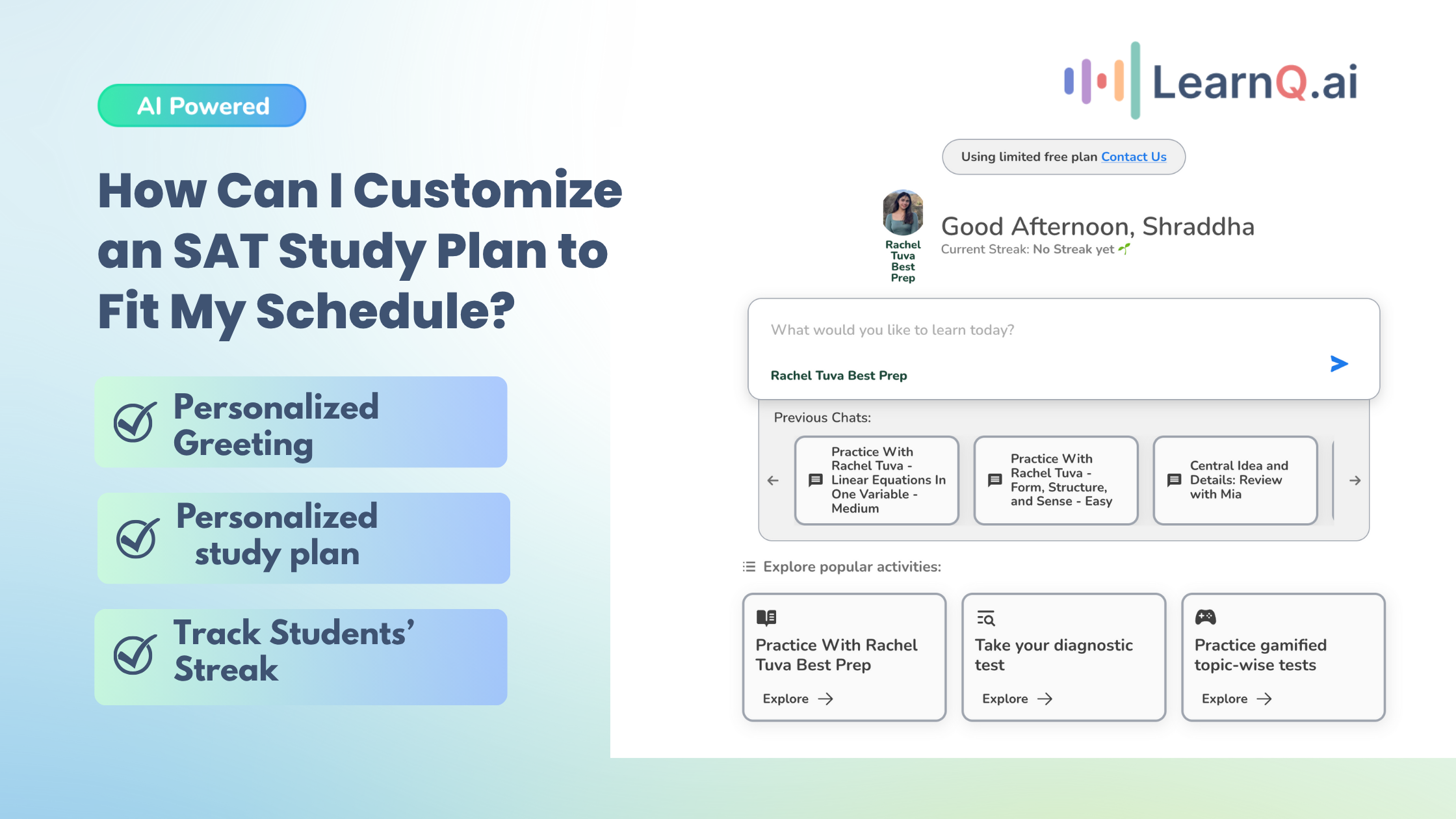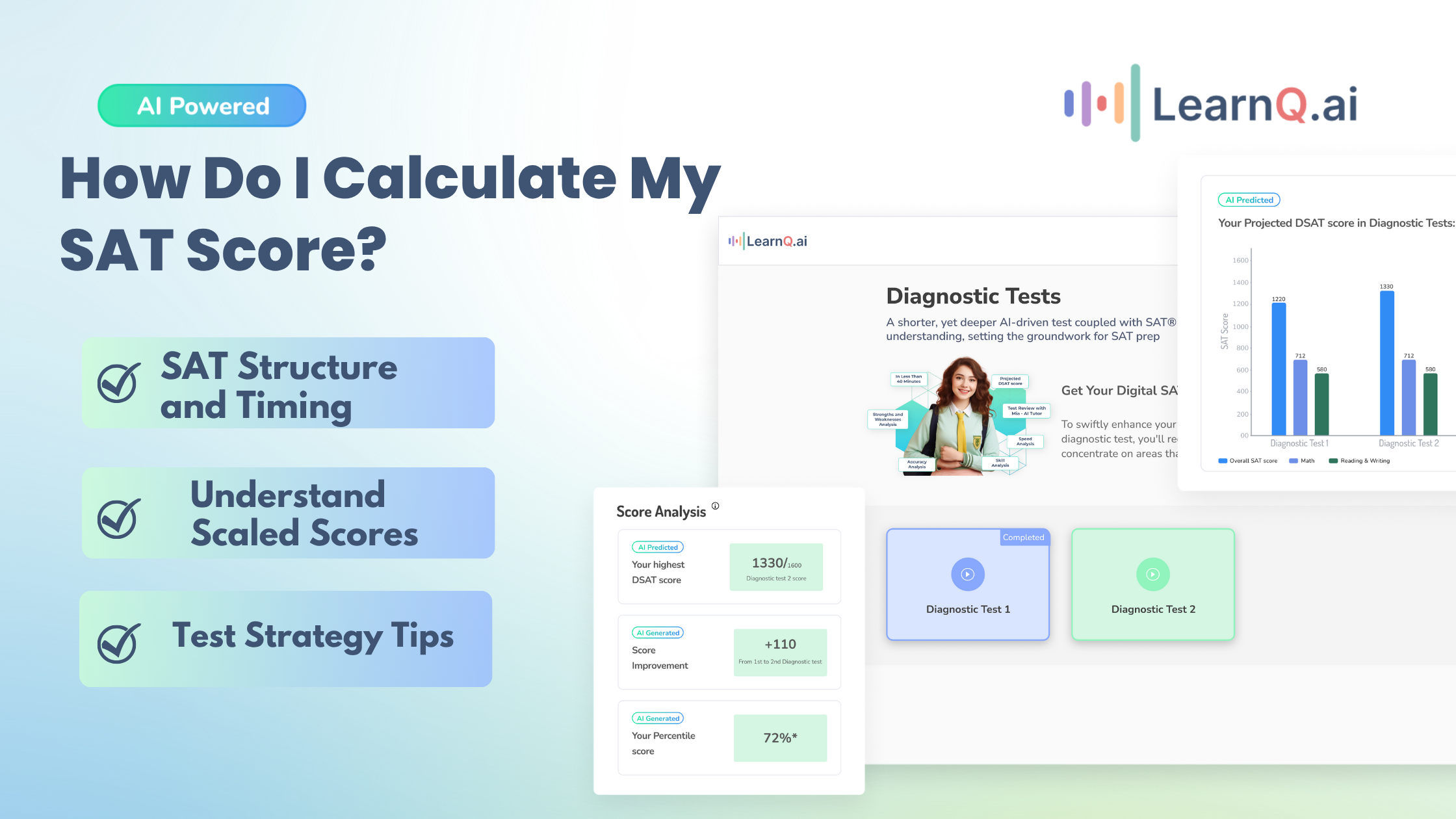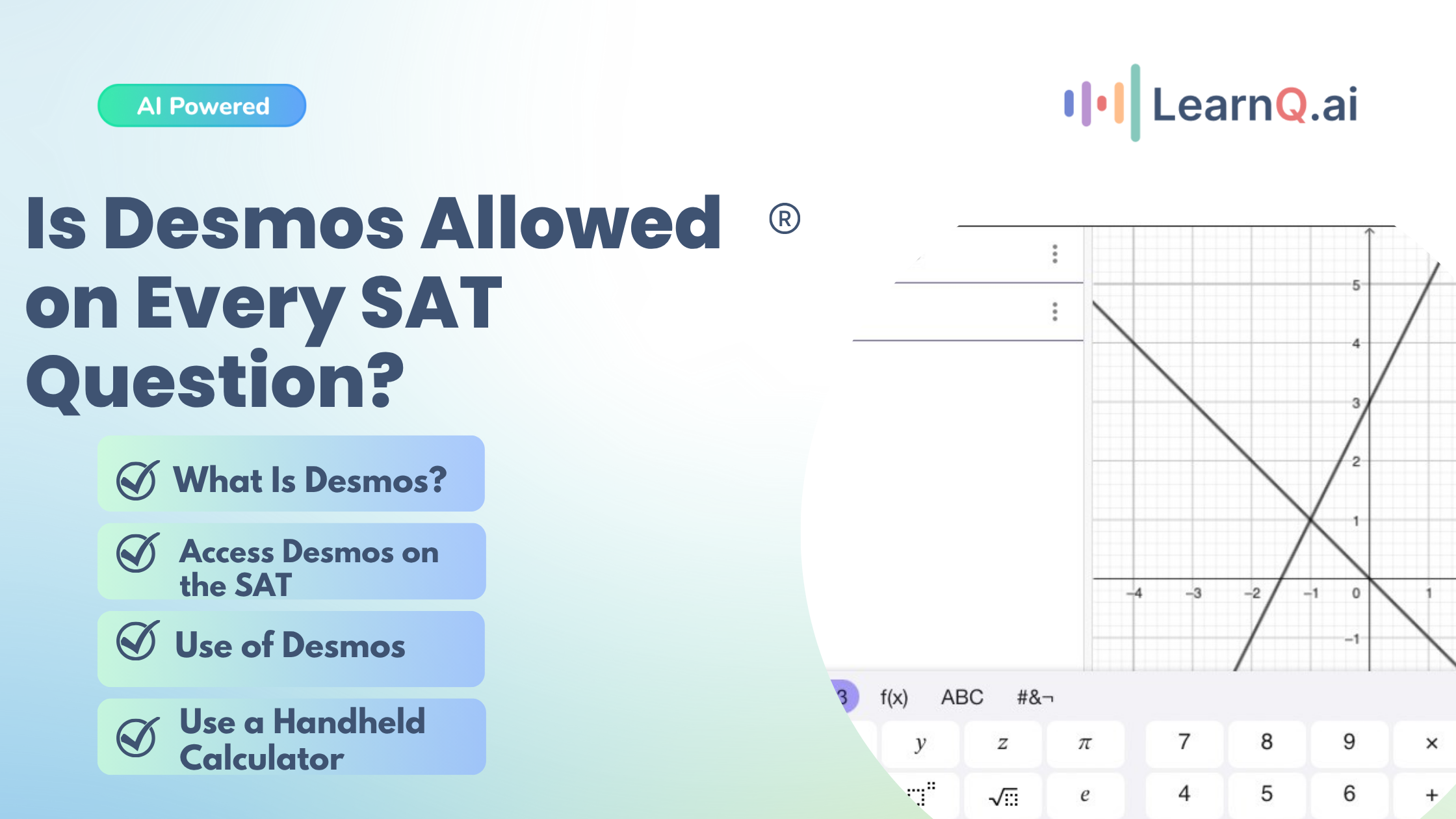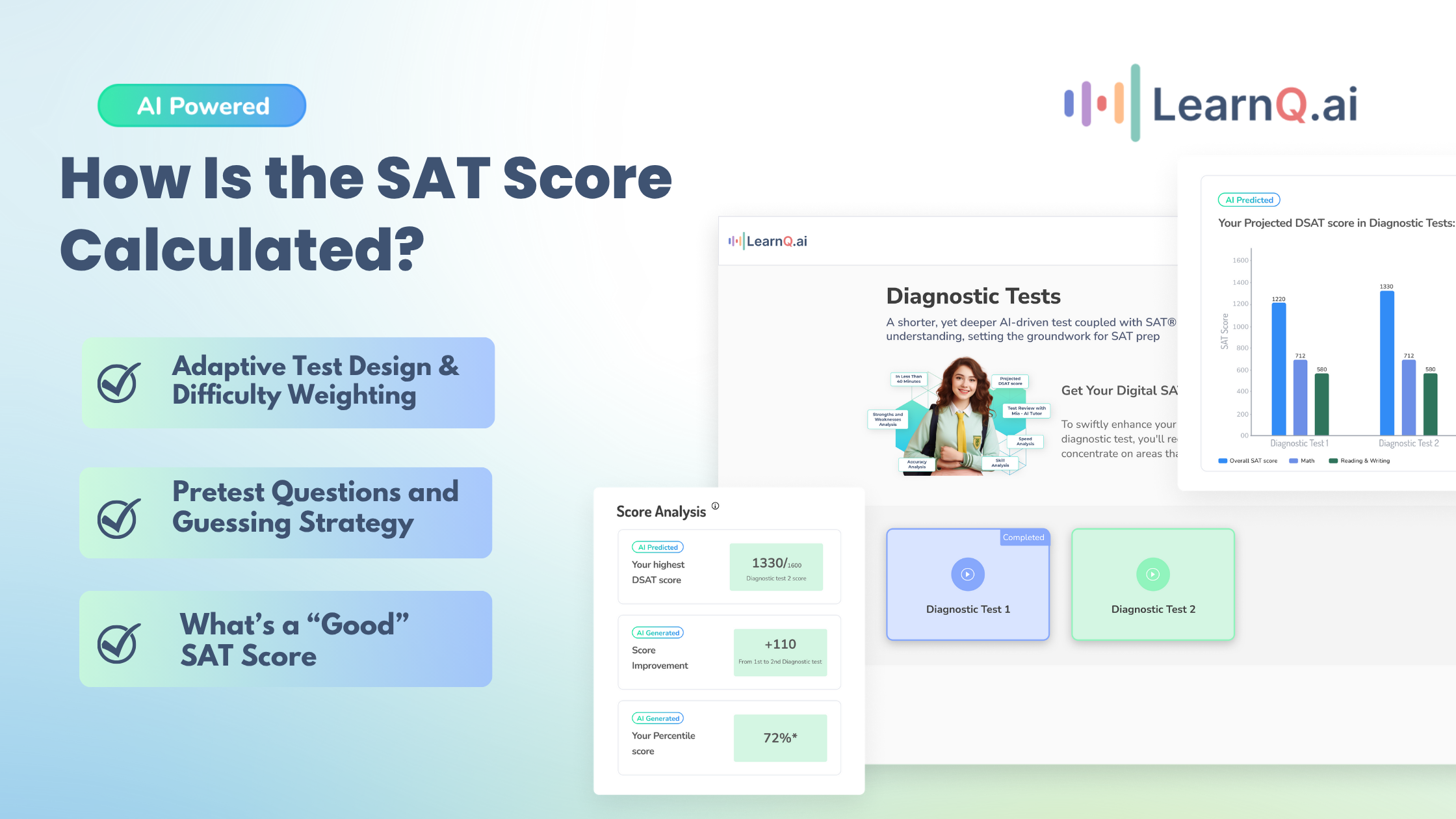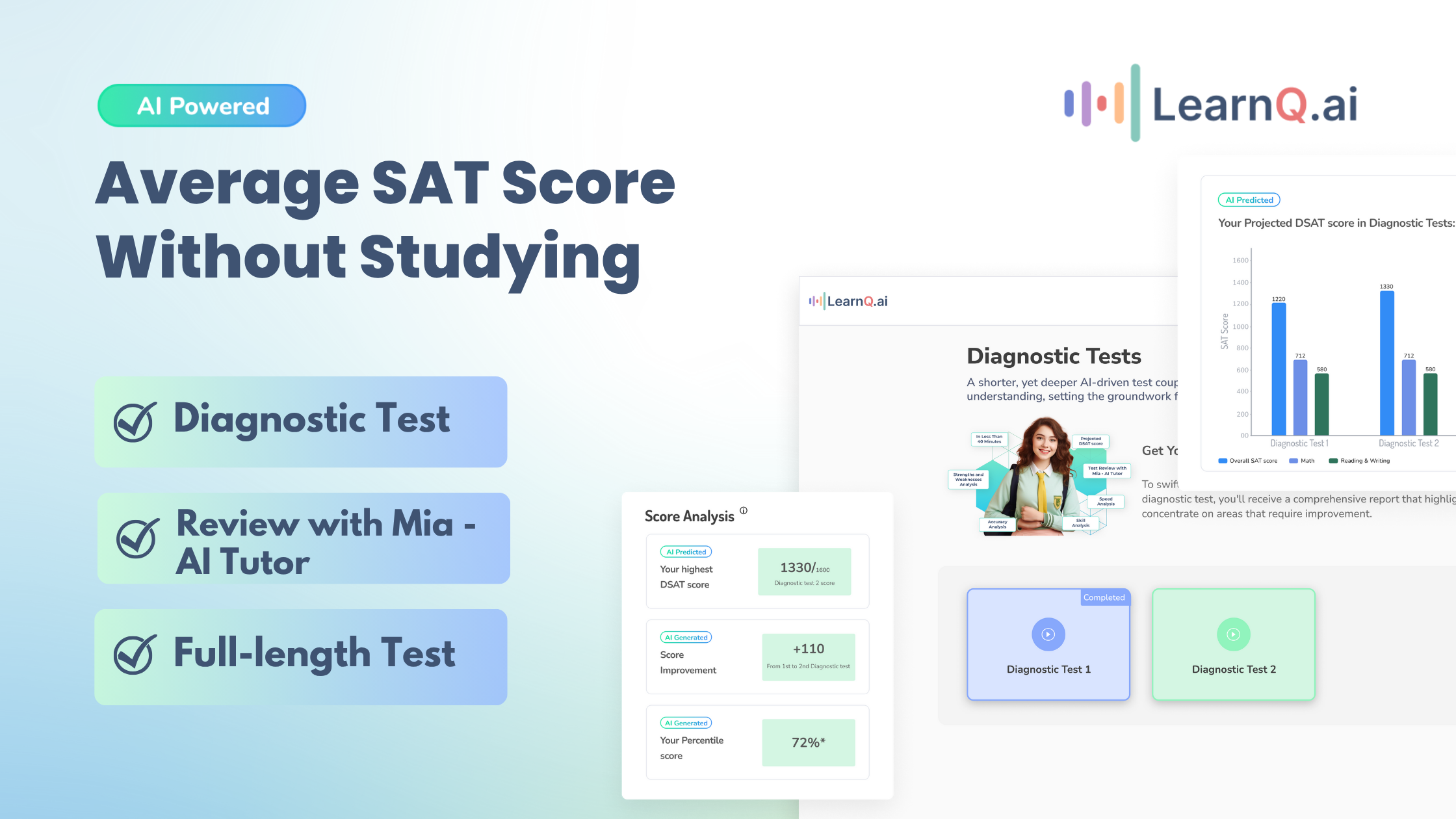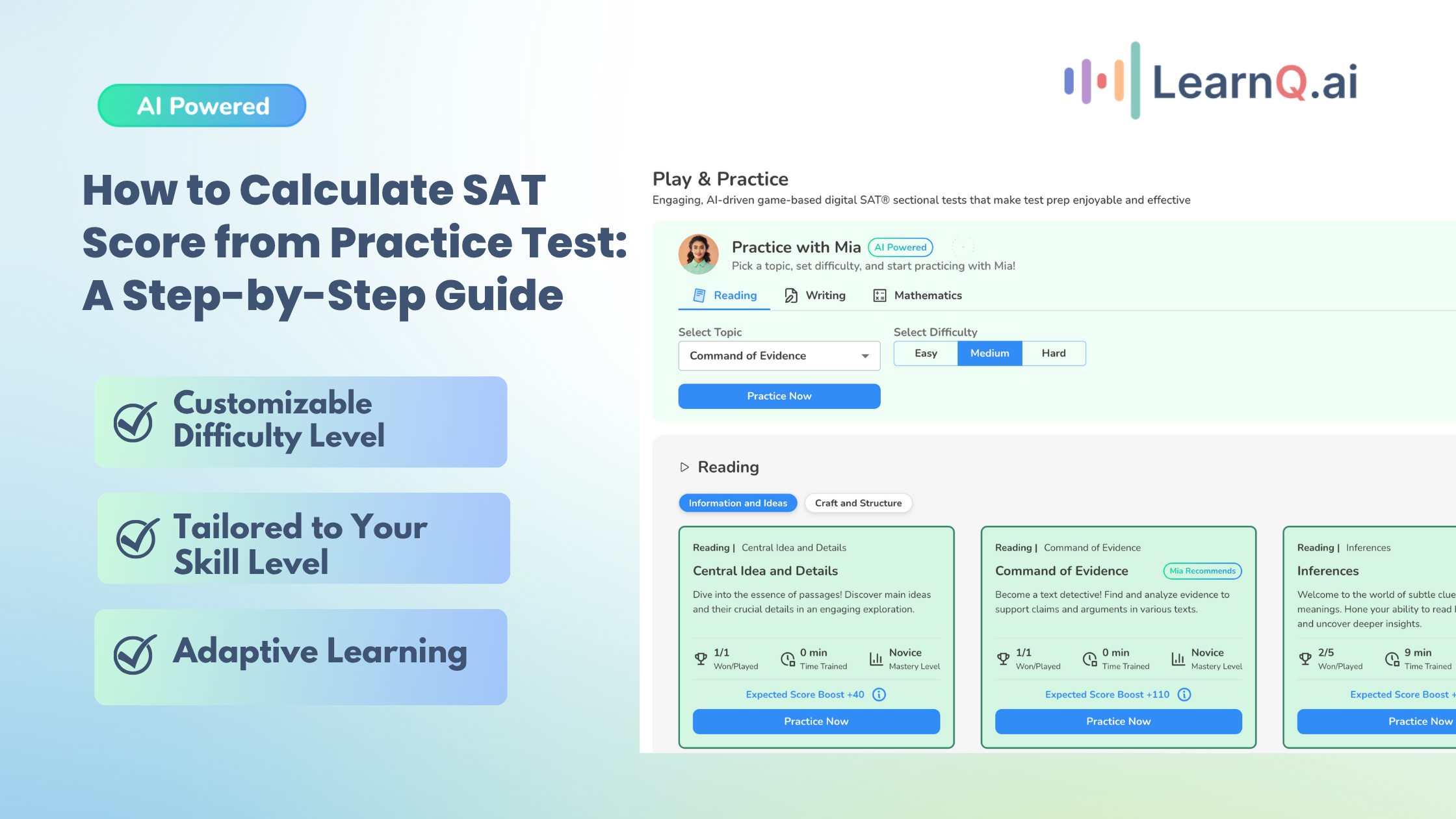If you’re gearing up for the SAT, you know the reading test can be one of the toughest sections, not just because of challenging passages but because of the strict time limit.
Effective time management is crucial to score well, with only 65 minutes to tackle 52 questions.
Mastering time management can make all the difference for students focused on maximizing scores and for parents and educators dedicated to supporting them.
In this blog, you’ll learn everything you need to know: understand the SAT reading format, prepare for time efficiency, pace yourself during the test, and review and refine your strategies afterward.
Let’s jump right in!
LearnQ.ai is Powered by VEGA AI—Is your Institute Next?
Give students a Duolingo-style test-prep platform with Shopify-level customization for tutors and institutes.
Understanding the SAT Reading Test Format
Understanding the structure of the SAT reading test is the first step to effectively managing your time on it.
Knowing the layout of the passages, the types of questions, and the timing can help you plan your approach and avoid feeling rushed. Here’s a breakdown of what to expect:
Structure of the Reading Section
The SAT reading test is designed with a particular structure, and understanding it will help you manage your time:
Total Time and Questions
You have 65 minutes to answer 52 questions, each with four answer choices.
That gives you roughly 75 seconds per question, so keeping a close eye on the clock is essential.
Passage Setup
The reading section has a total of 5 passages:
- 4 Single Passages and 1 Paired Passage Set.
- Each passage or passage set is between 500–750 words.
Knowing that each passage comes with 10-11 questions is helpful to manage your time.
Try to aim for around 13 minutes per passage, which includes both reading and answering questions.
This pacing will leave you enough time to finish all the questions without rushing.
Types of Passages
The SAT reading test features passages from three main subject areas: U.S. and World Literature, History/Social Studies, and Science.
Each passage type requires a slightly different approach. Let’s break them down.
U.S. and World Literature Passage:
- Quantity: 1 passage
- Questions: 10 questions
This passage is usually a novel or short story narrative. You’ll be looking at themes, character emotions, and relationships, so paying attention to these details is essential.
For example, if a passage describes a conversation between two characters, look for clues about their feelings toward each other or the overall tone.
Tip: When reading literary passages, try to understand the main theme and focus on the relationships and emotions described. Don’t get too bogged down in every word; focus on the bigger picture.
Enhance your Digital SAT study routine with AI-driven insights and personalized practice tests.
History/Social Studies Passages:
- Quantity: 2 passages, or 1 single passage and 1 paired passage set
- Questions: 10-11 questions each
These passages come from history or social sciences, like psychology or economics.
One may include a paired passage set, where you’ll have two shorter passages on the same topic from different perspectives.
These passages can be challenging because they often have older or more formal language.
A paired passage might require you to compare and contrast the authors’ views, which can take extra time if you’re unprepared.
Tip: It helps to quickly identify the main argument or purpose for history or social science passages. In paired passages, note how each author feels about the topic, as this will save you time when answering comparison questions.
Science Passages
- Quantity: 2 passages, or 1 single passage and 1 paired passage set
- Questions: 10-11 questions each
These passages cover topics like biology, chemistry, or physics and can sometimes include data, such as charts or graphs.
While the scientific language might seem overwhelming, don’t let the jargon slow you down.
Instead, focus on the main idea and refer to specific terms or data as needed. Graphs and charts are often straightforward, asking you to interpret simple data points.
Tip: Skim the passage to understand the topic when working with science passages. Don’t spend extra time overanalyzing the data if it’s not directly tied to a question.
Understanding these passage types and knowing what to expect helps you plan your time wisely.
For example, since literature passages usually focus on theme and emotion, spend a little more time soaking in the details. In science passages, focus on the main idea and refer to more information only as needed.
For teachers and test-prep coaches, practicing each passage type with students can build confidence and improve pacing so they feel prepared to tackle the full test with strategies tailored to each unique section.
Once you understand the SAT reading test format, the next step is to focus on effective time management strategies before test day.
Pre-Test Preparation for Effective Time Management
It’s important to prepare with purpose to manage your time well on the SAT reading test.
Building strong reading habits, practicing with a timer, and improving your comprehension skills can all make a big difference on test day. Here are some practical steps to help you get ready:
Setting Up a Study Schedule
Good time management on the SAT reading test begins with a consistent, well-planned study routine.
Here’s how to create a study schedule that will help you build strong reading skills and keep you on track:
- Consistency is Key: Regular practice is essential to get comfortable with the different types of passages and questions you’ll encounter. Make it a habit to practice reading a few times weekly to build familiarity and speed.
- Create a Balanced Schedule: Aim for a mix of practice activities:
- Reading Practice: Set aside days just to read passages and practice comprehension without the time pressure.
- Timed Practice Sessions: Have days dedicated to working through passages with a timer (more on this in the next section).
- Review Days: Spend one day a week reviewing the questions you missed to understand your mistakes and learn from them.
- Tip for Educators: If you’re supporting students, emphasize the importance of consistency and guide them in setting a realistic schedule they can stick to. This structure will help them avoid cramming and build strong skills over time.
Practicing with Timed Exercises
Timed practice helps you get used to the SAT’s time constraints so you don’t feel rushed on test day. Practicing under timed conditions trains you to answer questions quickly and accurately.
- Start Small with Timed Exercises: Begin by timing individual passages. Give yourself about 13 minutes per passage, and stick to that limit. As you get more comfortable, work up to practicing multiple passages within the full 65-minute time frame to build stamina.
- Simulate Test Conditions with LearnQ: Platforms like LearnQ offer timed full-length SAT practice tests that mimic the real SAT environment. This feature of LearnQ helps you feel the pressure of the actual test, which can reduce anxiety and improve your focus when the real test day arrives.
- Tip for Students: Don’t worry if you can’t finish within the time at first; speed comes with practice. Instead, focus on building accuracy and speed up your answers.
Building Reading Comprehension Skills
Strong reading comprehension skills are the foundation of effective time management on the SAT Reading test.
The more you understand on your first read, the less time you’ll need to re-read or search for answers.
- Techniques to Improve Comprehension and Speed: Here are a few simple ways to build comprehension:
- Summarize as You Read: After each paragraph or section, pause and quickly summarize the main idea in your head. This will help you keep track of key points.
- Identify Keywords: Look for keywords or phrases that signal important ideas or transitions, like “however,” “in contrast,” or “because.”
- Practice Skimming: You don’t have to read every word slowly. Learn to skim less important details while still picking up the main ideas, especially on first read-throughs.
- Using LearnQ Resources for Skill Building: LearnQ has targeted reading exercises focusing on reading speed, comprehension, and vocabulary, which are all valuable for the SAT reading test. Practicing with these resources can strengthen your ability to understand complex ideas quickly and respond accurately.
With a solid pre-test preparation plan, it’s time to focus on strategies for managing your time effectively during the test.
Time Management Strategies During the Test
Managing your time during the SAT Reading test can feel challenging, but with the right strategies, you can stay on track and make the most of every minute.
Here are some practical tips to help you read efficiently, prioritize questions, and keep pace throughout the test.
Effective Reading Strategies
Choosing the right reading technique for each passage can save you time and help you focus on what’s important.
Skimming
Skimming helps you quickly understand the main idea without getting lost in details.
This technique works well for simpler passages with familiar topics or clear arguments, often seen in literature or social science sections.
- When to Skim: Use skimming for straightforward passages that don’t have complex language or structure. For instance, in a passage discussing a general social science concept, you might skim to get the main argument and key examples without focusing on every line.
- How to Skim: Focus on each paragraph’s first and last sentences, as they often summarize the main points. Pay attention to bold or italicized words and topic sentences. You aim to get the general idea and understand the author’s main point without getting detailed.
Detailed Reading
Detailed reading is essential for passages with complex ideas, technical terms, or dense information, especially in history and science.
- When to Read in Detail: Use detailed reading for passages with challenging language, technical terms, or historical context that requires careful attention. For example, a science passage with specific terminology or a history passage with old-fashioned language will likely need a closer read.
- How to Read in Detail: Slow down and focus on each paragraph to understand the main points. Pay attention to transitions like “however” or “therefore,” which signal shifts in the argument. Break down long sentences and look closely at any examples or data provided.
Use Tools like LearnQ to Improve Reading Skills
LearnQ provides interactive tools to help you build essential reading skills for the SAT, making your study sessions more targeted and effective.
Each feature focuses on a specific skill area, allowing you to choose the difficulty level (easy, medium, hard) and practice what you need most. Here’s what LearnQ offers:
- Command of Evidence: Practice finding and analyzing evidence to support claims. This skill is crucial for answering questions that ask you to back up statements or identify supporting details in the passage.
- Central Idea & Details: This feature helps you quickly understand a passage’s main point and key details, allowing you to focus on what’s essential without getting lost.
- Inferences: Develop your ability to read between the lines and uncover hidden meanings. This skill is useful for questions that require you to go beyond what’s directly stated.
- Words in Context: Strengthen your vocabulary by understanding how words are used in different contexts. This helps you tackle questions about word meanings and their role in the passage.
- Text Structure & Purpose: Learn to recognize the author’s intent and how a passage is organized. This skill helps you understand the passage’s flow and purpose, making it easier to answer structure-based questions.
- Cross Text & Connections: Practice connecting ideas across multiple texts, an essential skill for paired passage questions that ask you to compare and contrast perspectives.
Enhance your Digital SAT study routine with AI-driven insights and personalized practice tests.
Also read: How to get started with LearnQ.ai for FREE?
Question Prioritization
Being strategic with questions can make a big difference in how much you get through in the time given.
- Tackling Easier Questions First
Questions that point to specific lines or details in the passage are often quicker to answer, so start with these.
Skim the questions before reading the passage to understand what you’ll need to look for as you read.
- Identifying Time-Consuming Questions
Some questions, like those about the overall theme or requiring comparisons, may take longer.
If you’re running short on time, skip these and return to them after answering the quicker, more straightforward questions.
- Using Process of Elimination (POE)
Cross out answers that are clearly wrong. This often leaves you with fewer options and makes it easier to spot the correct answer.
Practicing POE can save you much time per question and keep you from second-guessing.
Allocating Time Wisely
Sticking to a time plan for each passage and question helps avoid feeling rushed or running out of time.
- Suggested Time Per Passage
As mentioned above, try to spend around 13 minutes per passage, including reading and answering questions. This pace allows you to finish all passages within the 65-minute limit.
- Keeping Track of Time
Check your progress after each passage. If you take over 13 minutes, adjust your speed slightly on the next passage to stay on track.
This way, you’re less likely to run out of time in the last few passages.
- Handling Difficult Passages and Questions
If a passage or question is particularly challenging, don’t let it eat up too much of your time.
Mark it to come back to and move on to the next question. This keeps your momentum and helps ensure you don’t lose easy points.
After setting up solid time management strategies for approaching the test, let’s examine some techniques to help you stay focused and on pace during the actual test.
In-Test Time Management Techniques
Managing time well during the SAT reading test can be tricky, especially under pressure.
Here are some simple but effective techniques to help you stay on track and keep calm.
Using a Timer
A timer can help keep you aware of the clock without letting time control you. Here’s how to use it effectively:
Set Clear Benchmarks
Aim to finish each passage, including questions, in about 13 minutes. This keeps you on pace to complete the section in 65 minutes without feeling rushed.
For example, by the 25-minute mark, you should be starting your third passage.
Glance, Don’t Stare
Check the time between passages or every few questions, but avoid constant clock-watching.
Instead, use your benchmarks to monitor your progress so you know when to speed up or if you have extra time to review.
Practice Timing at Home
During practice sessions, use a timer to build a natural sense of pacing.
This will help you feel more comfortable with the test’s timing and less stressed about watching the clock on test day.
Handling Anxiety and Pressure
Anxiety can make time feel even tighter, so managing your nerves is key to staying focused and efficient. Here are some quick techniques to help with test-day nerves:
Breathe to Stay Calm
Deep breathing helps you slow down and regain focus. Try this simple exercise:
- Inhale slowly through your nose for a count of three.
- Hold for one second.
- Exhale through your mouth for a count of three.
Repeat a couple of times to clear your mind and ease tension.
Stay Present and Positive
If you feel overwhelmed, remind yourself that you’ve practiced and are prepared. Focus on one passage or question at a time rather than thinking about the entire test.
Positive self-talk, like “I’m ready for this,” can help you stay calm and confident.
Use Simple Grounding Techniques
Take a quick moment to notice your surroundings and reconnect with the task.
Something as simple as shifting your position or taking a quick sip of water can help you refocus.
Lastly, once you’ve completed the test, reviewing your performance is key to refining your approach and improving with each practice session.
Reviewing and Adjusting Strategies Post-Test
Reviewing and adjusting your performance after each practice test is key to improving your SAT Reading timing and accuracy.
Here’s how to get the most out of your review sessions and keep progressing.
Analyzing Practice Test Results
Reviewing your practice test results gives you a clear picture of what’s working and what needs improvement.
- Pinpoint Strengths and Weaknesses
Take note of the types of questions or passages you answered correctly and where you struggled. For instance, are science passages taking you more time?
Do certain question types, like inference or tone, slow you down? Knowing your strong and weak areas helps you focus on your future practice.
- Track Progress with LearnQ
LearnQ provides a detailed, data-driven approach to help you analyze your results over time.
By tracking your scores, accuracy, and time management across practice tests, you can see where you’re improving and where to focus next.
LearnQ’s personalized approach shows you where to gain the most points, helping you master concepts faster.
- Tip for Teachers and Tutors
Encourage students to keep a simple progress log, noting any patterns or improvements they notice in their performance.
This shows improvement and motivates them to keep working on specific areas.
Continuous Learning and Adaptation
Improvement in the SAT reading section comes with ongoing practice and regularly adjusting your strategies based on your latest results.
- Set Specific, Achievable Goals
Based on your test results, set realistic goals. If timing is an issue, gradually reduce your time on certain passages or question types.
If accuracy is a struggle, focus on mastering one type of question at a time, like the main idea or evidence-based questions.
- Adapt Strategies with LearnQ’s Diagnostic Tool
LearnQ offers a free diagnostic test that gives you a current snapshot of your SAT strengths and weaknesses. This personalized feedback helps you create a study plan that targets your needs.
The diagnostic test also helps you set clear goals, like improving comprehension or focusing on certain passage types.
- Stay Flexible and Adjust as Needed
Don’t be afraid to tweak your study approach as you learn more about your own strengths and challenges.
For example, if you notice that certain strategies are improving your reading speed, double down on those methods.
If a technique isn’t working, try a different approach until you find what works best.
Also read: SAT Practice Tests with Customizable Difficulty Levels
LearnQ.ai is powered by VEGA AI—Is your institute next?
Offer students a Duolingo-style test-prep platform with Shopify-level customization for tutors and institutes.






Conclusion
Mastering time management on the SAT reading test requires good preparation, practice, and the right tools.
Setting up a clear study schedule, knowing when to skim or read carefully, and reviewing each practice test will help you build speed and confidence.
LearnQ offers helpful support with AI-powered feedback that shows you how to improve your accuracy, pacing, and focus.
With features like a free personalized study plan, projected SAT score estimates, and test reviews from AI Tutor Mia, you’ll have everything you need to find and strengthen weak areas.
LearnQ’s tools also include a friendly Discord SAT students community to keep you motivated and on track to reach your goal.
So why wait? Get started with LearnQ for free; no card is required. Boost your SAT prep and SAT reading timing with personalized, data-driven support.

